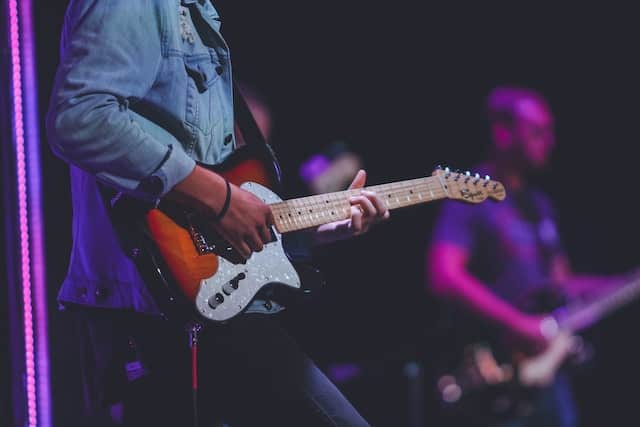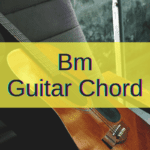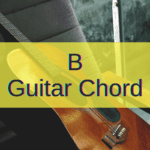With an Open D tuning, you have a lot of options.
It is obviously popular for playing slide guitar but many musicians use it without a slide as well.
And it’s a great way to try to spark some creativity if you feel like you’re stuck in a creative rut. So let’s explore some of the things you can do with it.
Open D tuning is pretty versatile with just a few chord shapes. Since some songs in Open D can tend to sound the same since the D Major chord is used so often, I encourage you to add some color to your compositions with some uncommon chord voicings. Don’t let the open tuning dictate how you compose.
Trying a new tuning can understandably seem daunting at first, especially after all the hard work you’ve put into learning to play in traditional tuning.
Since you may not want to re-learn all of your open chords, we will check out some chord shapes that you can use all the way up the fretboard with ease.
And once you feel comfortable with the basics you can start experimenting or playing some songs that were written for this tuning.
What is an open tuning on guitar?
An open tuning means that when the guitar is strummed and none of the strings are fretted, the strings will play a major chord.
In this case with Open D tuning, the notes are D, A, and F#.
So playing while fretting across all of the strings at the same fret will give you a major chord anywhere on the guitar. Just navigate by the root note on the 6th string.
This is why open tunings are so great for slide guitar.
Additionally, Open E tuning, which is EBEG#BE, has the same intervals between strings as Open D.
So you can also play songs that are written for Open E, just a full step lower. Or put a capo on the second fret and you have proper Open E.
How to tune your guitar in Open D?
With your guitar in standard tuning and assuming it is correctly tuned, you can get to Open D tuning in a couple of minutes pretty easily.
But for the bottom three strings, the order is important.
- First, tune your 6th string down a full step until fretting it at the 7th fret matches the tone of the 5th string played open (A).
- Next, hold the 4th string at the 4th fret (F#) and tune the 3rd string down a half step until it matches.
- Now tune your 2nd string down a full step until it matches the 3rd string fretted on the 3rd fret (A).
- Finally, tune your 1st string down a full step until it matches the 2nd string held at the 5th fret (D).
Recheck the strings from top to bottom to see if any adjustments need to be made and play your three D strings in sequence to see if they sound like correct octave intervals. Do the same for the two A strings.
Don’t worry if this seems like a lot to do at first; it’s much easier than it sounds.
Open D tuning chord shapes
We are not going to focus on open chords too much since that isn’t what this tuning is really for.
Instead, I will give you some chord shapes for D, G, and G# chords that have some open notes and don’t require fretting more than three notes.
This way you can easily barre across where the open strings are and move up the fretboard for different notes.
So with only a few shapes, you will have dozens of different chords.
You do need to pay attention to where the root note is on some of these chords though. The root of the chord is not always on the uppermost strummed string like in Standard tuning barre chords.
But don’t worry; I will point out the chords that function like this and put the root notes in bold font.
Open chords
I don’t recommend trying to use this one as a barre chord since it would be quite a stretch but it sounds cool.
Alternate D7 chord shape 0 0 0 3 3 4 – D A D A C F#

Major chords
It doesn’t get much easier than this does it?
D Major 0 0 0 0 0 0 – D A D F# A D

Minor chords
Here is the first of our movable chord shapes with a sneaky root note (on the 3rd string).
G Minor x x 0 1 1 0 x – x D G Bb D

Seventh chords
D7 0 0 0 0 3 0 – D A D F# C D

And a G7 chord with the root note on the 3rd string again.
G7 x x 0 1 2 3 – x x D G B F

Sus2 and Sus4
Gsus2 x x 0 1 0 0 – x x D G A D (root on 3rd string)

Dsus4 0 0 0 1 0 0 – D A D G A D

Others
C# Diminished is useful to know for chord progressions in the key of D Major so we will include it as well (root note on the 3rd string).
But first, here is the “open” movable chord shape at G#.
G#Dim x x 0 2 2 0 – x x D G# B D

C#Dim x x 5 7 7 5 – x x G C# E G

Open D tuning scales
D Major scale: DEF#GABC#
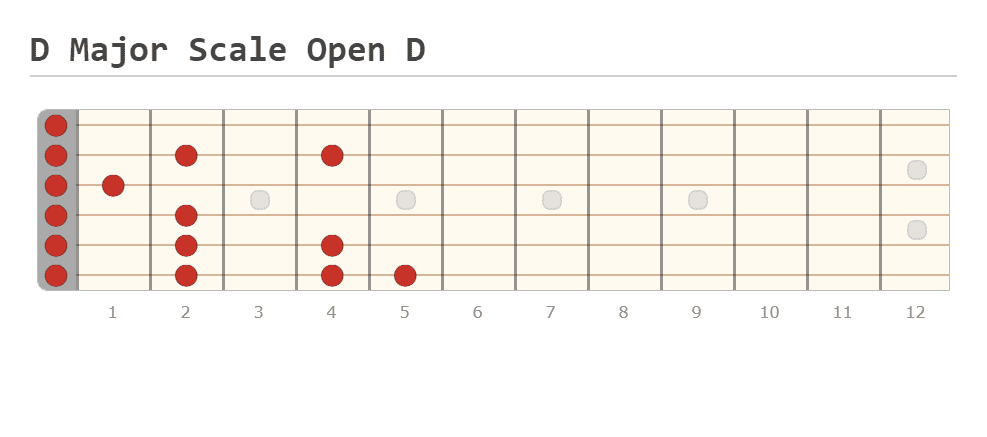
D Minor Pentatonic: DFGAC
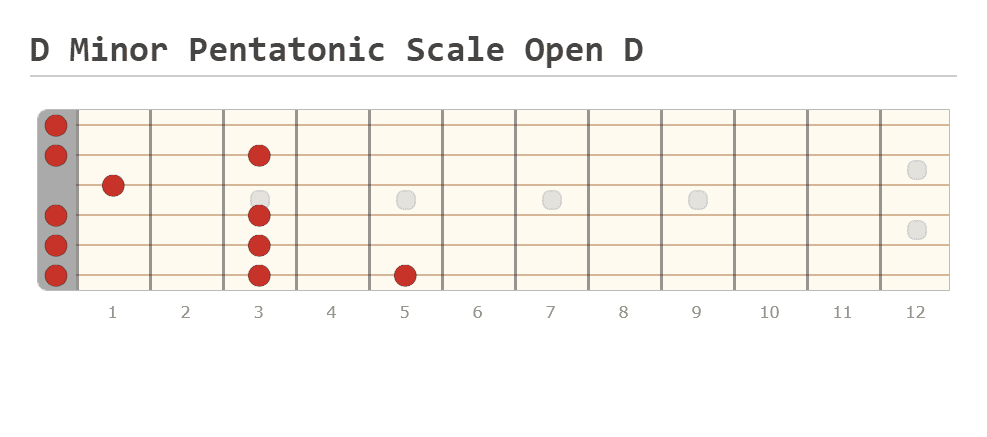
I think that should be plenty to get you started for scales in Open D tuning.
How to solo in Open D
For soloing in Open D I would recommend getting very comfortable with that Minor Pentatonic scale.
And since the interval between the 1st and 2nd strings is the same as standard tuning you can still use bending tricks such as fretting the 2nd string 3 frets higher than the 1st string and bending up a whole note to get that slightly dissonant but awesome sound.
If you have a strong interest in playing lead guitar, I recommend checking out this helpful video on Blues style soloing in Open D since this guy is better at soloing than I really care to be:
Playing Open D with a slide
Open tunings really shine when it comes to playing slide guitar. Because you have a major chord tuning, most of the hard work is already done for you.
So it really comes down to mastering the touch and working on that cool vibrato sound.
And don’t forget that if you’re playing slide guitar along with someone in a different tuning like Standard and you want Open E tuning for the song you just have to put a capo at the 2nd fret.
I will link to a couple of videos that should help you get started.
Open D tuning songs to play right away
Once you’ve digested enough of this to tackle some songs, here are some that I think will make great choices.
Big Yellow Taxi
Joni Mitchell’s Big Yellow Taxi is a famous song to (sort of) use this tuning. And the lyric “They paved paradise and put up a parking lot” still resonates just as strongly over 50 years later.
I believe this song uses Open D tuning with a capo on the 2nd fret, actually making it Open E tuning but I think I would prefer it without the capo since I don’t have Joni Mitchell’s vocal range.
Paris, Texas
I wanted to include Ry Cooder’s Paris, Texas partly just to introduce you to Ry Cooder if you have never listened to him.
He has done some great music and collaborated with many musicians from all over the globe, exposing many types of World music to a larger audience.
This one uses two guitars with slides in Open D tuning, but I think you can recreate it with one guitar fairly well.
Loser
Loser by Beck is a great song that isn’t too hard to play. And even though it’s about 30 years old I think it has aged pretty well.
There is more than one guitar in the song but I’m sure you can do a reasonable facsimile with only one guitar. Here is the main riff (slide guitar):
Even Flow
Also from the same period is Even Flow by Pearl Jam.
This one has one guitar in Open D tuning and another in standard tuning. Here is the basic riff:
Okay, I think it’s time for you to write your own amazing songs in Open D tuning now.
By the way, the chords in a typical D Major chord progression are as follows: D Major, E Minor, F# Minor, G Major, A Major, B Minor, and C# Diminished.
Get to it!

Hello there, my name is Ramiro and I’ve been playing guitar for almost 20 years. I’m obsessed with everything gear-related and I thought it might be worth sharing it. From guitars, pedals, amps, and synths to studio gear and production tips, I hope you find what I post here useful, and I’ll try my best to keep it entertaining also.

